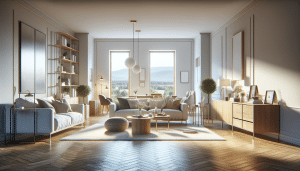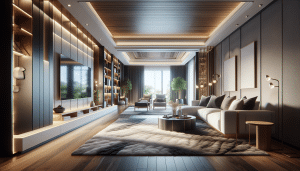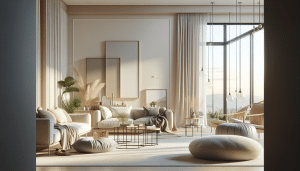Finding Your Perfect Minimalist Home Style
Jessica White September 2, 2025
Curious about minimalist home design and how it influences your lifestyle choices? This guide unpacks the essentials of creating tranquil spaces, choosing the right decor, and making sustainable selections for a more relaxed, efficient, and calming home environment.
Minimalism as a Lifestyle Choice
Minimalism is more than a trend—it’s a lifestyle transformation that encourages simplicity and intentional living. Adopting a minimalist home style centers around decluttering, embracing functional design, and prioritizing what truly matters. Many turn to this approach seeking a sense of peace and less stress in their daily lives. A minimalist house doesn’t mean living without personality or warmth; rather, it means surrounding yourself only with items that bring value or joy. This home design method supports conscious consumerism and helps minimize distractions, creating a sanctuary for relaxation. The core of minimalism is living deliberately, with every decor and furnishing choice reflecting personal meaning and practical purpose.
One surprising benefit people discover when adopting minimalist home design is how it influences mental health. The reduction in visible clutter can lower anxiety and provide visual cues for mindful living, as noted in research from leading wellness organizations (https://www.health.harvard.edu/mind-and-mood/the-benefits-of-mindfulness). Minimalism fosters an environment that encourages clarity of thought and purposeful action. Those who explore minimalism report feeling more freedom and flexibility, as their homes require less upkeep. The time saved on cleaning can be reinvested into hobbies, relationships, or self-care activities, making the lifestyle shift deeply rewarding in daily routines.
Adapting to minimalist living doesn’t require drastic action overnight. Many start gradually—clearing one room at a time or opting for versatile furniture with hidden storage. Minimalist home style often overlaps with sustainable living, as reducing unnecessary purchases lessens environmental impact and encourages responsible consumption (https://www.epa.gov/recycle/reducing-waste-what-you-can-do). A minimalist home design can evolve with changing needs, easily updated with subtle decor swaps or adaptable layouts. This flexibility ensures that your living environment always aligns with lifestyle goals and personal growth.
Elements of Minimalist Home Design
Minimalist home decor is marked by clean lines, neutral tones, and an airy, open feel. The philosophy centers around function—every piece of furniture or art should have a reason for being. White walls, streamlined furniture, and natural materials often become staples, reflecting both simplicity and timelessness. Embracing minimalism means letting go of excess and focusing on a few statement pieces that anchor the room, giving space for light and positive energy to flow. Even those new to home design find minimalist principles comforting, as they reduce the overwhelm of decorating choices.
Lighting is another pillar of minimalist home style. Natural light is prioritized in minimalist interiors because it enhances overall wellness and highlights the beauty of simplicity. Open window treatments, sparse window coverings, and mirrors can all amplify the natural brightness within a room. When artificial light is necessary, fixtures are chosen for clean silhouettes and soft, ambient glow to avoid visual clutter. Such choices support restful sleep and healthy circadian rhythms—essential for balanced, everyday life (https://www.cdc.gov/sleep/about_sleep/sleep_hygiene.html).
A minimalist home often incorporates organic textures and subtle pops of color to combat monotony. Wooden accents, stone planters, and woven textiles bring warmth and personality without overwhelming the senses. Carefully selected minimalist decor—vases, trays, or a single piece of abstract art—creates impact while adhering to the ‘less is more’ doctrine. This approach not only feels up-to-date and refined, but it can also be easier on the budget, as purchases are intentional and long-lasting. Sustainability and style go hand-in-hand in the modern minimalist home.
Decluttering Strategies and Mindset
Decluttering is an essential step in achieving a minimalist home. Many begin the journey by categorizing belongings into keep, donate, or recycle piles. This intentional review of possessions helps clarify what is truly meaningful. Decluttering isn’t about living with nothing; it’s about living only with essentials and things that spark joy, as popularized by the mindful organization movement. Storage solutions like built-in shelving or multifunctional furniture support a tidy, streamlined appearance, reducing visual stress and making spaces feel tranquil.
The mindset behind decluttering can have profound effects on overall well-being. Regularly reviewing household items reinforces decision-making skills and cultivates gratitude for what’s present. Minimalist home style enthusiasts often mention that purging excess paper, unused kitchen gadgets, and forgotten wardrobe items leads to newfound motivation and satisfaction. Over time, these small efforts reinforce the values of simplicity, moderation, and self-awareness—characteristics that translate into other areas of life (https://www.apa.org/topics/personality/minimalism).
Sticking to a minimalist mindset involves regular maintenance and mindfulness. One effective tool is the one-in, one-out rule—every new purchase triggers the removal of a similar item. This keeps clutter at bay and encourages thoughtful shopping habits. Involving other household members in the decluttering process ensures that everyone’s needs and preferences are acknowledged, making the minimalist lifestyle more sustainable for the entire family. Ultimately, decluttering is an act of self-care and an ongoing journey, not a one-time event.
Sustainable Choices for Minimalist Living
Minimalist living and sustainability are closely linked. Opting for fewer, higher-quality items means buying less, which reduces waste in the long term. Conscious selection of eco-friendly products—such as bamboo flooring, reclaimed wood furniture, and low-VOC paints—promotes healthier indoor environments and supports global environmental stewardship (https://www.epa.gov/greenhomes/what-makes-home-green). Many home decor brands now offer sustainable lines that blend minimalist aesthetics with environmental responsibility. This empowers consumers to make a positive impact right from their living rooms.
Another way minimalist homes foster sustainability is by reducing energy consumption. Open layouts and minimalist design allow for more efficient heating, cooling, and lighting. Choosing LED light fixtures, investing in energy-efficient appliances, and installing programmable thermostats all contribute to lower utility bills and a reduced carbon footprint (https://www.energy.gov/energysaver/energy-saver). Thoughtful window placement and proper insulation further optimize comfort and environmental benefits without sacrificing minimalist beauty or function.
Minimalist principles can extend into routine maintenance and upcycling. Many people embrace creative reuse—turning old jars into storage, restoring vintage furniture, or crafting decor from natural materials. Not only does this align with eco-conscious values, but it also adds personal flair to the home. Community efforts, such as donating unused items or participating in local swaps, enhance the sense of connection, reinforcing the social value of minimalist lifestyle choices.
Personalizing Minimalism for Everyday Life
Minimalism doesn’t mean sacrificing comfort or personal expression. The most satisfying minimalist homes are those that reflect the unique tastes and needs of their inhabitants. This could mean a reading nook adorned with only beloved books, an art wall showcasing a curated collection of meaningful pieces, or a calm space dedicated to meditation. Personal touches like family photos, inherited ceramics, or a single, favorite houseplant infuse the home with warmth. Even within minimalist rules, individuality shines through.
Technology can enhance everyday minimalist living. Smart storage solutions, such as modular closets and hidden compartments, blend seamlessly into pared-down spaces. Minimalist design also aligns with the growing trend toward digital decluttering—storing documents, recipes, and memories in digital form rather than on overflowing shelves. Tools like home organization apps simplify the management of daily life, freeing up both physical and mental space for what matters most (https://www.nia.nih.gov/health/home-safety-and-organization-tips).
Lastly, creating a minimalist home is a journey best enjoyed at your own pace. Trends come and go, but the core values of minimalism remain. Stay open-minded, assess needs regularly, and don’t be afraid to adapt as family size, routines, or priorities evolve. The goal is a peaceful, flexible space that supports well-being and gives back more than it takes—making every day feel lighter, clearer, and more intentional.
References
1. Harvard Health Publishing. (n.d.). The benefits of mindfulness. Retrieved from https://www.health.harvard.edu/mind-and-mood/the-benefits-of-mindfulness
2. U.S. Environmental Protection Agency. (n.d.). Reducing waste: What you can do. Retrieved from https://www.epa.gov/recycle/reducing-waste-what-you-can-do
3. Centers for Disease Control and Prevention. (n.d.). Sleep hygiene tips. Retrieved from https://www.cdc.gov/sleep/about_sleep/sleep_hygiene.html
4. American Psychological Association. (n.d.). The benefits of minimalism. Retrieved from https://www.apa.org/topics/personality/minimalism
5. U.S. Environmental Protection Agency. (n.d.). What makes a home green? Retrieved from https://www.epa.gov/greenhomes/what-makes-home-green
6. U.S. Department of Energy. (n.d.). Energy Saver. Retrieved from https://www.energy.gov/energysaver/energy-saver








